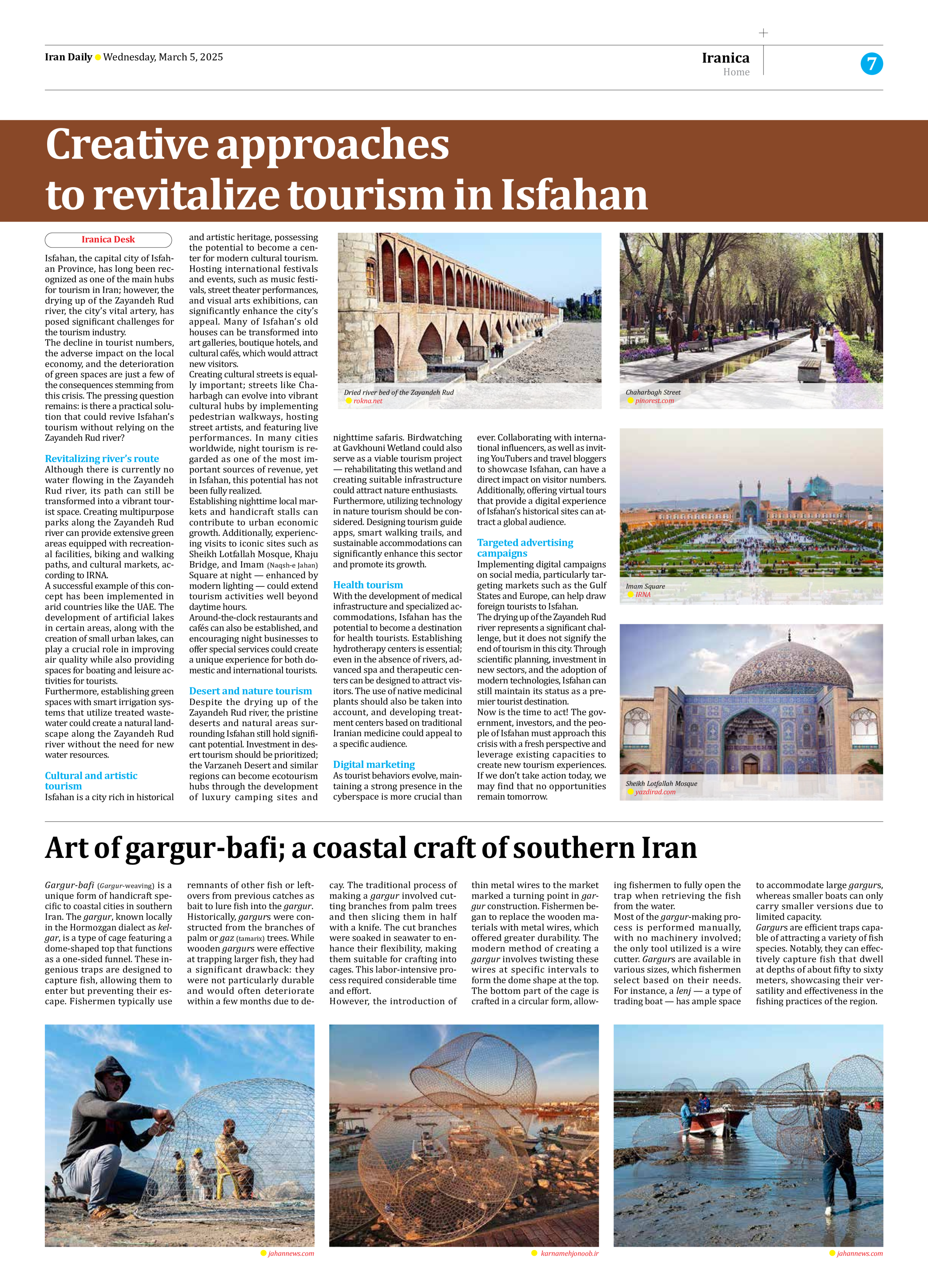
Creative approaches to revitalize tourism in Isfahan
Isfahan, the capital city of Isfahan Province, has long been recognized as one of the main hubs for tourism in Iran; however, the drying up of the Zayandeh Rud river, the city’s vital artery, has posed significant challenges for the tourism industry.
The decline in tourist numbers, the adverse impact on the local economy, and the deterioration of green spaces are just a few of the consequences stemming from this crisis. The pressing question remains: is there a practical solution that could revive Isfahan’s tourism without relying on the Zayandeh Rud river?
Revitalizing river’s route
Although there is currently no water flowing in the Zayandeh Rud river, its path can still be transformed into a vibrant tourist space. Creating multipurpose parks along the Zayandeh Rud river can provide extensive green areas equipped with recreational facilities, biking and walking paths, and cultural markets, according to IRNA.
A successful example of this concept has been implemented in arid countries like the UAE. The development of artificial lakes in certain areas, along with the creation of small urban lakes, can play a crucial role in improving air quality while also providing spaces for boating and leisure activities for tourists.
Furthermore, establishing green spaces with smart irrigation systems that utilize treated wastewater could create a natural landscape along the Zayandeh Rud river without the need for new water resources.
Cultural and artistic tourism
Isfahan is a city rich in historical and artistic heritage, possessing the potential to become a center for modern cultural tourism. Hosting international festivals and events, such as music festivals, street theater performances, and visual arts exhibitions, can significantly enhance the city’s appeal. Many of Isfahan’s old houses can be transformed into art galleries, boutique hotels, and cultural cafés, which would attract new visitors.
Creating cultural streets is equally important; streets like Chaharbagh can evolve into vibrant cultural hubs by implementing pedestrian walkways, hosting street artists, and featuring live performances. In many cities worldwide, night tourism is regarded as one of the most important sources of revenue, yet in Isfahan, this potential has not been fully realized.
Establishing nighttime local markets and handicraft stalls can contribute to urban economic growth. Additionally, experiencing visits to iconic sites such as Sheikh Lotfallah Mosque, Khaju Bridge, and Imam (Naqsh-e Jahan) Square at night — enhanced by modern lighting — could extend tourism activities well beyond daytime hours.
Around-the-clock restaurants and cafés can also be established, and encouraging night businesses to offer special services could create a unique experience for both domestic and international tourists.
Desert and nature tourism
Despite the drying up of the Zayandeh Rud river, the pristine deserts and natural areas surrounding Isfahan still hold significant potential. Investment in desert tourism should be prioritized; the Varzaneh Desert and similar regions can become ecotourism hubs through the development of luxury camping sites and nighttime safaris. Birdwatching at Gavkhouni Wetland could also serve as a viable tourism project — rehabilitating this wetland and creating suitable infrastructure could attract nature enthusiasts.
Furthermore, utilizing technology in nature tourism should be considered. Designing tourism guide apps, smart walking trails, and sustainable accommodations can significantly enhance this sector and promote its growth.
Health tourism
With the development of medical infrastructure and specialized accommodations, Isfahan has the potential to become a destination for health tourists. Establishing hydrotherapy centers is essential; even in the absence of rivers, advanced spa and therapeutic centers can be designed to attract visitors. The use of native medicinal plants should also be taken into account, and developing treatment centers based on traditional Iranian medicine could appeal to a specific audience.
Digital marketing
As tourist behaviors evolve, maintaining a strong presence in the cyberspace is more crucial than ever. Collaborating with international influencers, as well as inviting YouTubers and travel bloggers to showcase Isfahan, can have a direct impact on visitor numbers. Additionally, offering virtual tours that provide a digital experience of Isfahan’s historical sites can attract a global audience.
Targeted advertising campaigns
Implementing digital campaigns on social media, particularly targeting markets such as the Gulf States and Europe, can help draw foreign tourists to Isfahan.
The drying up of the Zayandeh Rud river represents a significant challenge, but it does not signify the end of tourism in this city. Through scientific planning, investment in new sectors, and the adoption of modern technologies, Isfahan can still maintain its status as a premier tourist destination.
Now is the time to act! The government, investors, and the people of Isfahan must approach this crisis with a fresh perspective and leverage existing capacities to create new tourism experiences. If we don’t take action today, we may find that no opportunities remain tomorrow.







